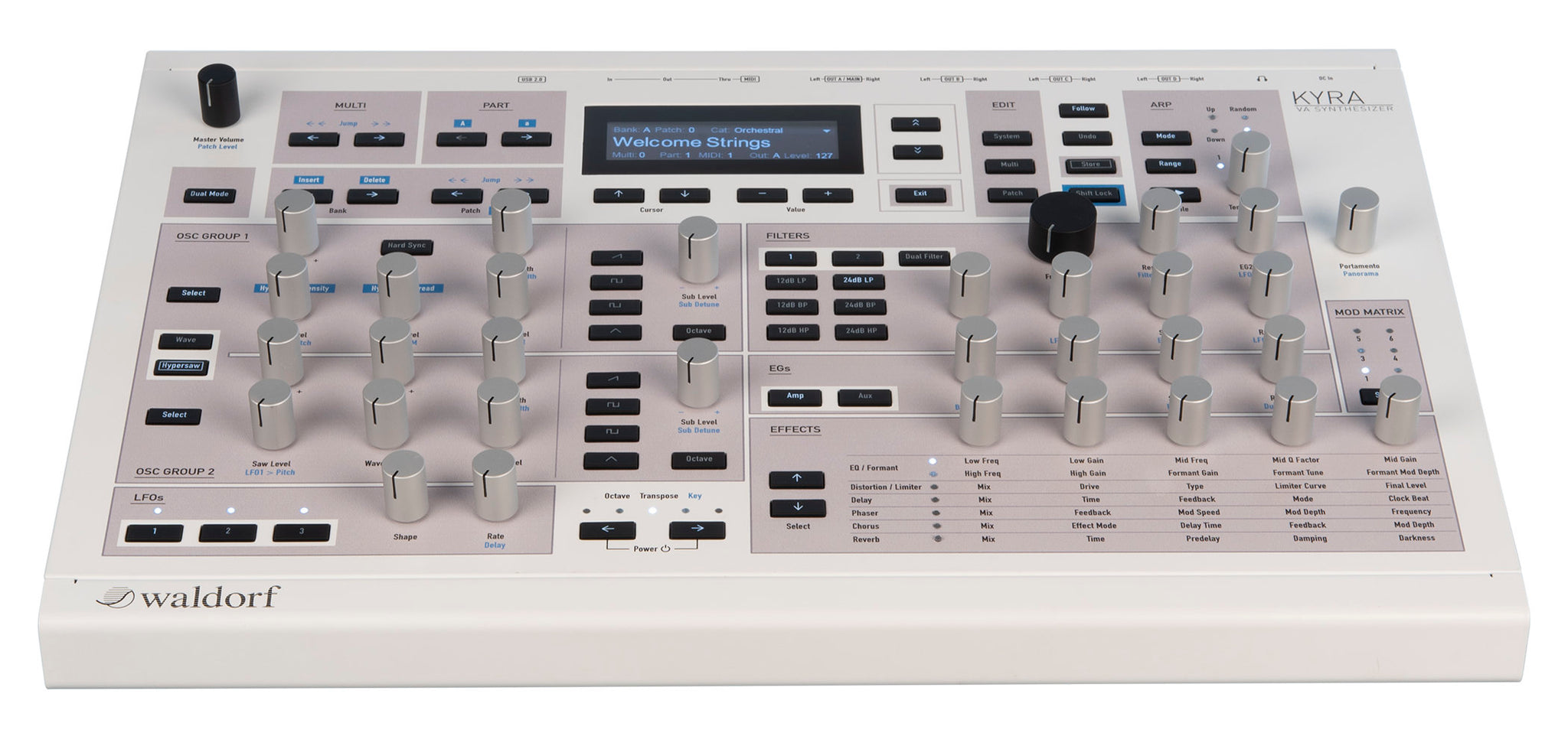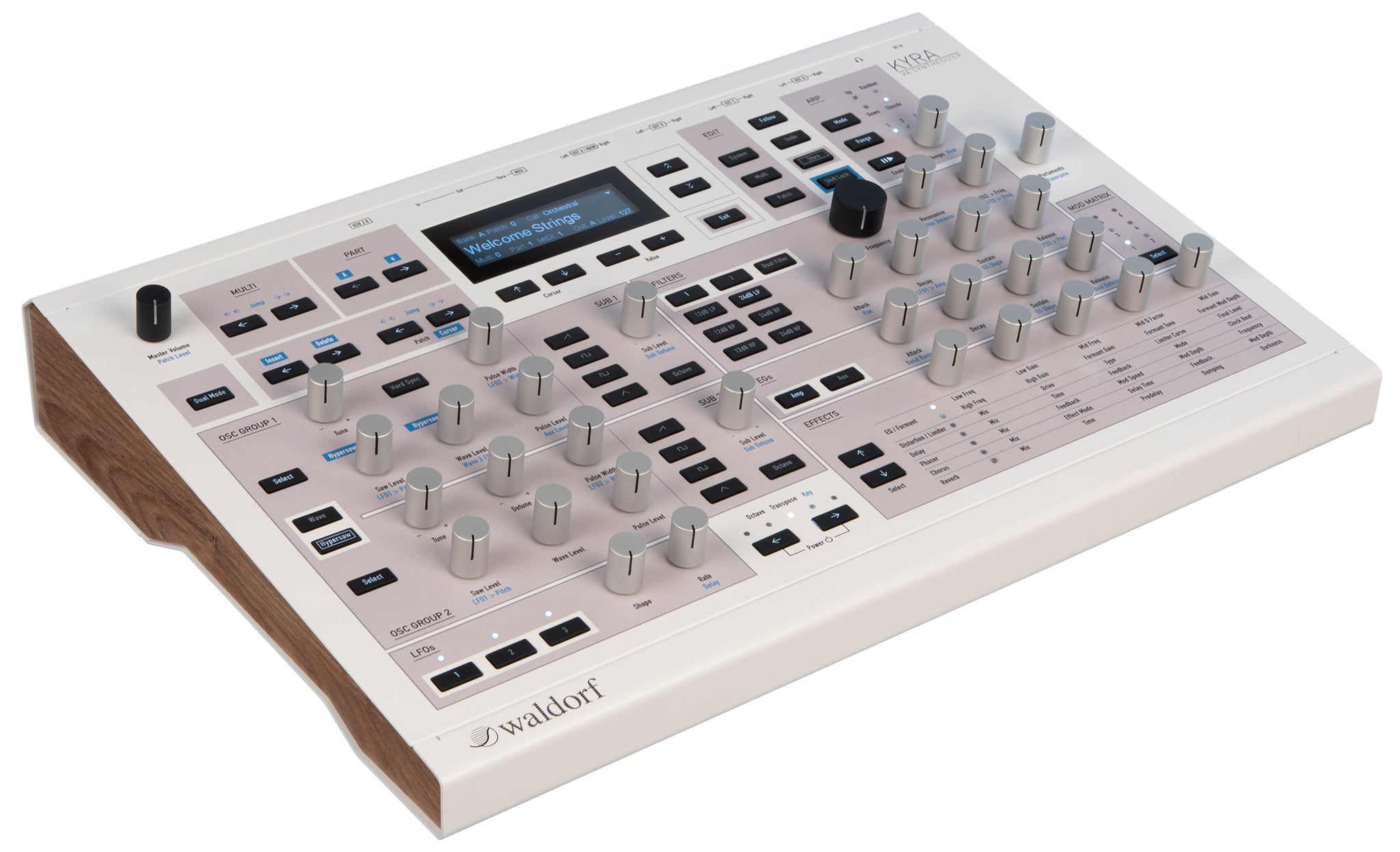
Waldorf Kyra
📦 Ships same day when ordered by 1pm PST. 🛍 Local pickup available daily. Contact us for more information. 💜
Waldorf Kyra VA Synthesizer
Kyra is a powerful, hardware virtual analog synthesizer capable of creating a wide range of contemporary sounds for live and studio musicians.
The striking fascia of Kyra, desktop VA Synthesizer, immediately conveys its beautiful design, with its wording artfully inscribed upon it.
Featuring 8 parts with up to 32 notes each, Waldorf Kyra is a multitimbral instrument that comprises four sound sources, filters, modulators, a multi-effects unit, and a USB 2.0 connection for MIDI and 24-bit/stereo audio exchange (at 96kHz or 48kHz downsample).
Boasting four balanced stereo output pairs, four internal stereo busses, and 128 hardware voices, the Waldorf Kyra features 32-bit DAC running at 96kHz sampling rate. Additionally, each PART is also equipped with nine stereo effect modules, including a three-band EQ, Formant filter, input Limiter, Distortion module, Delay module, six-state Phaser, Chorus flanger, Stereo reverb, and output Limiter, which stream dedicated audio via USB (Universal Serial Bus).
Patches
Kyra offers 3,328 patches across 26 banks (A to Z, each with 128 patches); 7 banks are RAM, and 19 are ROM, which can be copied from RAM to ROM and all made user-programmable. Patches can be recalled via MIDI program changes and Bank select commands.
Oscillators
Kyra offers 2 alias-free OSC GROUPS per voice, with SAW, Wave, Pulse, Noise, detune-able SUB 1 & 2 (4 selectable shapes, 2 selectable Octave pitches), Real Hard Sync, Ring Modulation & Frequency Modulation between oscillator groups, plus 4,096 18-bit PCM 32x oversampled waveforms.
Kyra's Wave & Hypersaw modes enable virtual analogue and harmonic soundscapes respectively. Dual Mode adds 12 oscillators and stereo spread.
Filter
Kyra's FILTERS panel facilitates accurate recreations of vintage analogue ladder filters, boasting dual and single parallel (Dual Filter) true stereo capability of up to 128 filters per configuration: 2-pole (12dB/oct) LP, BP, and HP, plus 4-pole (24dB/oct) LP, BP, and HP.
Envelope and LFOs
Three advanced ADSR envelope generators with EG Slope setting, a freely assignable VCA/filter, six MOD MATRIX channels with three dests. each, and three LFOs w/128 waveforms, mono/poly/random/anti-phase/stereo phase & MIDI clock sync.
Arpeggiator
Creativity continues courtesy of an arpeggiator (ARP) on each PART with 128 preset patterns; Up, Down, Random, and Chords modes; and an ability to synchronise to MIDI clock. Arpeggiators are aimed at live performance, primarily, but can clearly complement composition. Kyra’s ARP is an integral part of a Patch, so settings are always stored.
Display and Connections
Kyra harnesses a 256x64 pixel graphic OLED display, MIDI In/Out/Thru (five-pin DIN & USB 2.0), full key microtuning and MTS support - making it one of the most powerful synths ever. A sensational spec for superior sound design!
The Creation of the Waldorf Kyra Synthesizer – Frequently Asked Questions
What is Kyra?
Kyra is a powerful FPGA-based synthesizer capable of producing a large number of complex sounds simultaneously.
What type of musician/producer is Kyra aimed at?
Kyra suits pros and semi-pros in live or studio settings, with big sound, built-in effects and balanced analog/USB 2.0 outputs.
Why was Kyra created?
Kyra was created to fill a gap in the synthesizer market for a powerful digital, virtual analog synthesizer. Key to the design was to have no compromises on sound quality, ease of use, studio integration and raw power, all with a price tag that puts ownership within reach of producers working to a real-world budget.
How would you characterise Kyra’s sound?
Kyra's sound is immense, yet surprisingly delicate. Owing to oversampling, its clarity never wavers, and its capacity to create classic analog emulations astounds. As new patches are programmed, the impacts become greater, complementing the existing Waldorf range.
Tell me about this FPGA technology, what does it do for me as a musician?
Kyra, based on an FPGA, is the first professional synth of its kind. This offers benefits for musicians, including the processing power of a high end PC, but minus the slow startup, faulty OS, and heat issues. Kyra starts up quickly and uses 10 watts, compared to 250+ in a high-end PC.
Another benefit to this technology is reliability. As all of Kyra’s audio generation, filtering and processing is done on a single chip, reduced component counts mean Kyra is less expensive to build and is more reliable.
What is unique about Kyra? Why should I buy it?
There are few synthesizers, if any, that are as powerful as Kyra. There are some notable features on Kyra that would usually be associated with much more expensive instruments such as a solid, all-metal chassis, 32 bit “Velvetsound” DACs, multiple balanced audio outputs and multi-part audio streaming over USB.
So Kyra has four stereo outputs? How is that useful to me?
Kyra has four balanced stereo outputs, allowing you to process each Part with outboard effects or Kyra's on-board effects. You can level, pan, EQ and process each output as desired.
I understand Kyra has a comprehensive USB Audio implementation. Tell me more.
Kyra's USB 2.0 High Speed (480Mbits) audio and MIDI is reliable, streaming 8 Parts as 96kHz 24-bit studio-quality audio and accepting a single return audio stream.
Kyra's USB is USB Audio 2.0 compliant, with MacOS support out of the box and Windows 7+ with driver. Linux not officially supported. USB MIDI compliant too, no need for a MIDI interface unit.
With all that power, I bet Kyra is hard to program. Is this true?
Kyra is powerful and easy to program, enabling users to create their own sounds beyond factory presets and commercial patch banks. It offers a range of sound sources, filters, modulators and effects—all at a higher quantity, quality and modulation. With Kyra, you can start crafting new Patches right away.
OK but I guess there’s a lot of menu diving right?
Very little in fact. All of Kyra’s main functions have their own controls. Only a few more obscure functions require some menu navigation.
What type of display does Kyra have?
Kyra features an OLED display. This is a newer technology than the LCDs found on most synthesizers. It is much clearer and can be viewed from any angle.
I’m a power patch programmer, I need an Editor. Does Waldorf offer one?
Currently, Waldorf does not offer an Editor for Kyra. However, we expect good support by third party providers. Kyra has a comprehensive MIDI implementation to support this.
Is Kyra fully stereo?
Yes, Kyra offers a full stereo signal path. When configured for “Dual Mode” operation, there’s two complete sets of oscillators, filters and modulators and these feed into a full stereo effects chain. You can achieve very animated, stereo sounds with Kyra.
What’s Kyra’s build quality like? Can I rely on Kyra for live gigs?
Kyra is solid, you’ll feel that when you first use it. The chassis is made from high grade steel, the controls are custom made. The connectors are designed for professional use.
Tell me about Kyra’s effects?
Kyra's 8-part Patch features nine effects modules each, including a 3-band shelving EQ, formant filter, distortion, limiter, 6-stage phaser, delay line, chorus/flanger/comb, reverb and final output limiter, all oversampled in stereo. Live musicians can use Kyra's outputs as effects sends, while studio producers can use their favorite virtual effects.
Is it true that Kyra really has 1,280 oscillators?
Kyra has 1,280 real oscillators to produce powerful, detuned sounds. Stack them into a stereo hypersaw, or use FM, hard sync or the ring modulator.
Is Kyra really 128 note polyphonic? For real sounds not just simple ones?
Kyra plays 128 notes simultaneously (up to 32 per Part), always, regardless of settings and effects, except Dual Mode (2 channels per note). True polyphony, no maximums.
I hear Kyra’s waveforms are static? Is that true?
Kyra offers two oscillators per voice, with 4096 waveforms to choose from and options to cross-fade, ring modulate, FM and hard sync. Limitless possibilities!
Kyra Specifications
Sound engine
- Virtual analog synthesis.
- 128 voices.
- 8 parts.
- All sound features can be used simultaneously for each part.
Oscillators per voice
- two Wave osc with 4096 waveforms.
- two Pulse osc.
- two Saw osc.
- two Noise osc.
- two Sub osc with several waveforms.
- Hard Sync.
- Hypersaw Mode.
- Oscillator FM and Ring mod.
- Oscillators are in two groups for better overview.
Effects
- 9 simultaneously available effects.
3 band EQ, Formant Filter, Input limiter, Distortion module, Delay module, 6 stage phaser, Chorus flanger, Stereo reverb, Output limiter.
Modulators
- 3 envelope generators (EG).
- 3 LFOs with 128 shapes each.
- 6-slot Mod Matrix with multiple destinations per slot.
Filters
- 12/24db/octave with LP/BP/HP available. Two filters per voice and true stereo signal path available in Dual Mode.
Extras
- 26 patch banks (A to Z) with 128 slots each.
- 128 Multi configurations.
- Arpeggiator with 128 preset patterns.
- Octave/key transpose.
- Dual Mode: layers the same sound two times (which can be detuned against each other) .
and provides true stereo signal path, Dual Filters and stereo LFOs.
Hardware
- Sturdy full metal case.
- 256x64 pixel OLED.
- Kensington lock receptacle.
Connections
- USB 2.0 for MIDI and audio.
- 5-pin DIN MIDI In/Out/Thru.
- 4 stereo, balanced, analog audio outputs plus stereo headphone output.
Audio interface
- Kyra can be used as an audio interface to stream a single stereo stream from your computer.
- Kyra can stream its 8 parts individually to your computer via USB in stereo at 24bit/96KHz (48KHz option).
- USB MIDI and Audio 2.0 class complient - can be used with Mac OS and Windows (windows with supplied driver).





